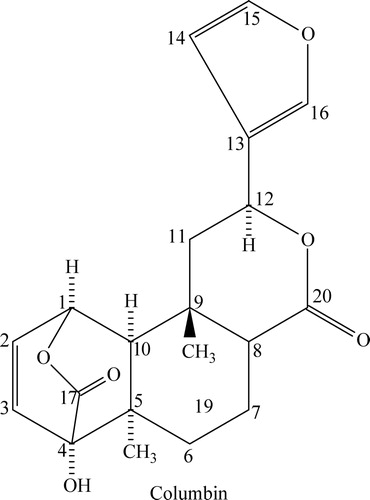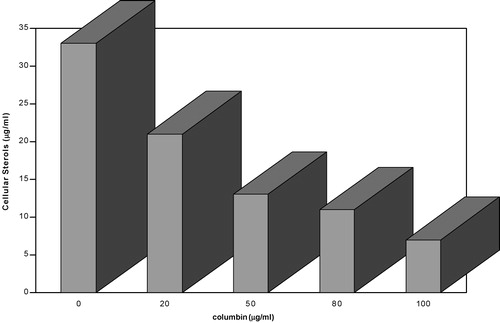Abstract
The diterpenoid furanolactone (columbin) from Aristolochia albida inhibited growth of culture forms of Trypanosoma brucei. In vitro analysis of the compound at 5–250 μg/ml showed complete lysis of the parasites within 10–20 minutes post incubation. At 50 μg/ml, columbin killed about 50% of the parasites which initially appeared swollen under phase contrast microscopy. Also the total amount of cholesterol diminished dose-dependently in the presence of 10–100 μg/ml of columbin after a 3-day incubation period.
In vivo analysis of the compound in T. brucei-infected mice revealed that 25 mg/kg administered for 3 consecutive days, completely cleared the parasites from the peripheral circulation. However, columbin could not clear parasites in the cerebrospinal fluid.
Introduction
Trypanosomiasis is a disease that affects both man and his domestic animals. It has been estimated that about 35 million people and 25 million cattle are at risk of infection with pathogenic trypanosomes [Citation1]. The life cycle of trypanosomes involves multiplication in body fluids of the mammalian host and in the gut and salivary glands of the insect vector of the tsetse fly. In the mammalian host, the variable surface glycoprotein (VSG) represents parasite adaptation in the mammalian host, providing it with an escape mechanism from the immune system [Citation2]. This has been the bane against discovery of a suitable vaccine.
The chemotherapy of trypanosomiasis is beset with several problems associated with the treatment range from a limited repertoire to protracted treatment protocols [Citation3]. On account of the foregoing, there is the pressing need for research into better and cheaper trypanocides. A considerable level of progress has been made in sourcing for antitrypanosomal agents from medicinal plants Citation4-6. Aristolochia albida is a medicinal plant whose constituents are active against the toxinomous action of snake venom [Citation7,Citation8]. The compound columbin (), a diterpenoid furanolactone from Calumbae radix, affects the sleeping time in anesthetized mice [Citation9]. In this report, the inhibition of sterol synthesis in T. brucei by columbin from A. albida is described.
Materials and methods
All reagents were purchased from Sigma Chemical Company St Louis, USA. Columbin was a generous donation form Dr. M.K. Choudhury of the Department of Pharmaceutical Chemistry, Ahmadu Bello University, Zaria, Nigeria. The compound was isolated and purified from Arostolochia albida and its purity confirmed by melting point analysis, NMR and GC-MS. Trypanosoma brucei EATRO 412 was supplied by the Department of Veterinary Parasitology, Ahmadu Bello University, Zaria, Nigeria. Balbc mice were purchased from the Department of Pharmacology, Ahmadu Bello University, Zaria, Nigeria and were housed for at least 7 days in an animal house before the experiments and fed standard diet and water ad libitum. All animal experiments were approved by the University Ethical Committee.
Cultivation of Trypanosome brucei
T. brucei parasites were cultivated as described by Hirumi et al. [Citation10] T. brucei cells were collected from infected Balb C mice and diluted with Dulbecco medium (GIBCO BRL) supplemented with 100 μM hypoxanthine, 30 μM thymidine, 40 μM adenosine, 1 μM sodium pyruvate, 50 μM l-glutamine, 60 μM 2-mercaptoethanol and 5% fetal calf serum.
About 1 ml of the heparinized blood containing 108 trypanosomes was dispensed into each well of 24 well tissue culture plates and incubated at 37°C with 5% CO2 and 95% air. Daily, 250 μl of fresh medium was added with the removal of the same amount of the spent medium. After three weeks the cultured long slender bloodstream forms were transferred into 25 cm2 tissue culture flasks containing 5 ml of the culture medium.
In-vitro sensitivity test
Fifty mg of columbin was dissolved in 200 μl 1% ethanol and gradually made up to 10 ml with phosphate buffered saline (PBS) pH 7.2. The preparation was dispensed into the 24 wells of a tissue culture plate in dilutions of 5–300 μg/ml. Into each well, 500 μl of the culture adapted bloodstream forms of T. brucei (106 cells/ml) was added and incubated at 37°C in 5% CO2 and 95% air. The control was incubated with phosphate buffered saline containing 1% ethanol. At the end of 5–30 min incubation, parasite survival was checked using a hemocytometer.
Effect of columbin on sterol and myristate uptake in blood stream forms of T. brucei
T. brucei was grown in the presence of 20–100 μg/ml columbin. After 3 days, of incubation, the parasites were harvested and passed through a DEAE cellulose column. After centrifuging at high speed, the packed parasites were lysed and analyzed for total sterol as described by Seary et al. [Citation11]
In vivo infection
Twenty mice were divided into 5 groups (A–E) of four each. The groups A–D were infected by intraperitoneal (i.p) inoculation with 104 trypanosomes. Group E members were not infected. After 48 h, treatment was commenced by i.p administration of 25 mg/kg/day of columbin at one, two and three dosages to the groups B, C and D respectively. The groups A and E were given normal saline only. Parasitemia was checked daily.
Sub-inoculation experiments
Two mice in the cured group D were sacrificed 6 weeks post treatment. The blood (2 ml) was used to inoculate two other healthy mice. Also their kidney, liver and spleen were washed, homogenized in PBS pH 6.8 and the filtrate used to inoculate two healthy mice. Further sub-inoculation was done with 0.2 ml of cerebra-spinal fluid (CSF) drawn by lumbar puncture from the cured mice into two healthy mice. Parasitemia was routinely checked in all the experimental mice.
Results
The diterpene furanolactone, columbin, from A. albida was found to have trypanocidal effects on blood stream forms of T. brucei in vitro (). At 10 μg/ml, the parasites ceased to be motile for about 4 min and resumed flagella movement. The same observation was made at 50 μg/ml accompanied by a loss of about 50% of the parasite population. All parasites were immobilized and killed at 250 μg/ml of columbin.
Table I. The trypanocidal effect of different levels of columbin (5–250 μg/ml). Trypanosome motility was observed by inspection of at least 100 trypanosmes under phase contrast microscopy.
Effect of columbin on cholesterol uptake in T. brucei
When columbin at 20–100 μg/ml was incubated with T. brucei, there was a dose-related fall in the total sterol content of the parasites. There was about 50% loss in total cholesterol at 20 μg/ml of columbin ().
In vivo experiments
The infected animals developed parasitemia 48 h after infection. After the administration of 25 mg/kg/day of columbin, there was complete elimination of the parasites from peripheral circulation in only group D that was treated for 3 consecutive days. Members of the B and C groups showed relapse and fulminating parasitemia. The cured mice in group D were further observed for a 6 week-period for any relapsing parasitemia. There was however no reoccurrence of any bouts of parasitemia ().
Table II. Effect of administration of columbin on different groups of T. brucei-infected mice.
Histopathological studies
Pathological analysis of formalin fixed sections of organs of the infected mice (A group) showed prominent kupffer cells in the liver, and erythrophagia of some kupffer cells in the liver. Also the epithelial cells of the proximal and convoluted tubules of the kidney were necrotized. The spleen was also abnormally enlarged. The cured mice revealed no signs of any pathology that denotes organ damage, except for a fairly enlarged spleen.
Discussion
In a previous report, we showed that columbin inhibits venom phospholipase A2-catalysed hydrolysis of ghost RBC and linked it to its anti-venom properties [Citation12]. Here we demonstrate the anti-trypanocidal effect of columbin in vitro and in vivo in experimentally T. brucei-infected mice. The compound inhibited the uptake of cholesterol in vitro by blood stream forms of T. brucei. This essentially implicates the steroid pathway of T. brucei as a target for the anti-trypanocidal action of columbin. African trypanosomes acquire fatty acids by the hydrolyses of host membrane lipids by parasite phospholipases [Citation13,Citation14] and exogenous cholesterol, by a receptor -mediated endocytosis of plasma LDL [Citation15,Citation16]. This cascade of events is vital in supporting the growth and maturity of trypanosomes prior to infectivity.
Columbin also had anti-trypanosomal effect in T. brucei-infected mice. The compound cured infected mice of trypanosomiasis without any relapse. That sub-inoculation of tissue homogenates of the cured mice, into healthy mice failed to elicit any parasitemia implies a complete clearance of the trypanosomes from peripheral circulation. However, mice inoculated with the cerebrospinal fluid started to showed parasitemia after 3 weeks. This observation suggests that columbin cannot cross the blood brain barrier. The ability of a compound to cross the blood-brain barrier largely depends on the ionization and lipid solubility of the compound [Citation17]. Considering the bulky nature of columbin and the possession of only a single electron-withdrawing group –OH at position-4, involved in intramolecular bonding [Citation17], its' hydrodynamic properties do not appear to support an easy passage across the brain barrier. This could be circumvented by coupling to compounds with the ability to cross the barrier. The potentials of improving the efficacy of columbin by coupling to transferrin is currently under investigation.
Acknowledgements
The support of the Alexander Von Humboldt Stiftung (AvH) Germany is acknowledged.
References
- Tropical Disease Research, 7th Program Report, 1 January 1983–31 December 1984. Chap 5,3–19. UNDP Program/World bank/WHO.
- Turner MJ. Adv Parasitol 1982; 21: 69–153
- Gutteridge WE. Br Med Bull 1985; 41: 162–168
- Nok AJ, Esievo KAN, Longdet I, Arowosafe S, Onyenekwe PC, Gimba CE, Kagbu JA. J Clin Biochem Nutr 1992; 13: 81–85
- Nok AJ, Adaudi A, Arowosafe S, Onyenekwe PC, Longdet I. Appl Vet Human Toxicol 1994; 36: 522–524
- Nok AJ, Williams S, Onyenekwe PC. Parasitol Res 1996; 82: 634–637
- Viswanath BS, Gowda TV. Toxicon 1986; 25: 929–937
- Haruna AK, Choudhury MK. Ind J Pharm Sci 1995; 27: 222–224
- Wada K, Kurihara T, Yagi M, Kobayashi R, Kaminaga H, Toi K, Haga M. Biol Pharm Bull 1995; 18: 634–636
- Hirumi H, Hirumi K, Peregrine AS. J Protozool Res 1993; 3: 52–63
- Searey RL, Berquist LM, Jung RC. J Lipid Res 1960; 1: 349–351
- Nok AJ, Balogun E, Lori J, Abubakar MS. J Enz Inhib Med Chem 2002; 17: 55–59
- Mellors A, Samad A. Parasitol Today 1985; 5: 239–244
- Nok AJ, Esievo KAN, Ibrahim S, Ukoha AI. Ikediobi. Cell Biochem Function 1993; 11: 125–130
- Coppens I, Baoudhuin P, Opperdoes FR, Courtoy PJ. Proc Natl Acad Sci 1988; 85: 6753–6757
- Coppens I, Courtoy PS. Mol Biochem Parasitol 1995; 73: 179–188
- Pappenheimer J, Heissey S, Jordan E. The Blood Brain. Selective Toxicity2 edn., A Adrien. John Wiley and Sons, New York 1961; 54–65
- Swaminathan K, Sinha UC, Ramakumar S, Bhatt RK, Sabata BK. Miers Acta Crystallogr 1989; 45: 300–303

